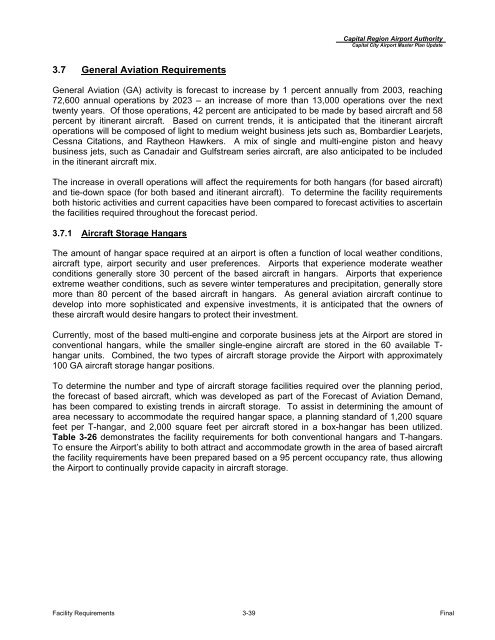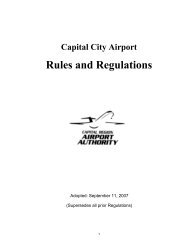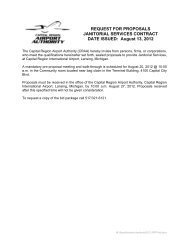Master Plan Update (pdf) - Lansing/Capital City Airport
Master Plan Update (pdf) - Lansing/Capital City Airport
Master Plan Update (pdf) - Lansing/Capital City Airport
You also want an ePaper? Increase the reach of your titles
YUMPU automatically turns print PDFs into web optimized ePapers that Google loves.
3.7 General Aviation Requirements<br />
<strong>Capital</strong> Region <strong>Airport</strong> Authority<br />
<strong>Capital</strong> <strong>City</strong> <strong>Airport</strong> <strong>Master</strong> <strong>Plan</strong> <strong>Update</strong><br />
General Aviation (GA) activity is forecast to increase by 1 percent annually from 2003, reaching<br />
72,600 annual operations by 2023 – an increase of more than 13,000 operations over the next<br />
twenty years. Of those operations, 42 percent are anticipated to be made by based aircraft and 58<br />
percent by itinerant aircraft. Based on current trends, it is anticipated that the itinerant aircraft<br />
operations will be composed of light to medium weight business jets such as, Bombardier Learjets,<br />
Cessna Citations, and Raytheon Hawkers. A mix of single and multi-engine piston and heavy<br />
business jets, such as Canadair and Gulfstream series aircraft, are also anticipated to be included<br />
in the itinerant aircraft mix.<br />
The increase in overall operations will affect the requirements for both hangars (for based aircraft)<br />
and tie-down space (for both based and itinerant aircraft). To determine the facility requirements<br />
both historic activities and current capacities have been compared to forecast activities to ascertain<br />
the facilities required throughout the forecast period.<br />
3.7.1 Aircraft Storage Hangars<br />
The amount of hangar space required at an airport is often a function of local weather conditions,<br />
aircraft type, airport security and user preferences. <strong>Airport</strong>s that experience moderate weather<br />
conditions generally store 30 percent of the based aircraft in hangars. <strong>Airport</strong>s that experience<br />
extreme weather conditions, such as severe winter temperatures and precipitation, generally store<br />
more than 80 percent of the based aircraft in hangars. As general aviation aircraft continue to<br />
develop into more sophisticated and expensive investments, it is anticipated that the owners of<br />
these aircraft would desire hangars to protect their investment.<br />
Currently, most of the based multi-engine and corporate business jets at the <strong>Airport</strong> are stored in<br />
conventional hangars, while the smaller single-engine aircraft are stored in the 60 available Thangar<br />
units. Combined, the two types of aircraft storage provide the <strong>Airport</strong> with approximately<br />
100 GA aircraft storage hangar positions.<br />
To determine the number and type of aircraft storage facilities required over the planning period,<br />
the forecast of based aircraft, which was developed as part of the Forecast of Aviation Demand,<br />
has been compared to existing trends in aircraft storage. To assist in determining the amount of<br />
area necessary to accommodate the required hangar space, a planning standard of 1,200 square<br />
feet per T-hangar, and 2,000 square feet per aircraft stored in a box-hangar has been utilized.<br />
Table 3-26 demonstrates the facility requirements for both conventional hangars and T-hangars.<br />
To ensure the <strong>Airport</strong>’s ability to both attract and accommodate growth in the area of based aircraft<br />
the facility requirements have been prepared based on a 95 percent occupancy rate, thus allowing<br />
the <strong>Airport</strong> to continually provide capacity in aircraft storage.<br />
Facility Requirements 3-39 Final




